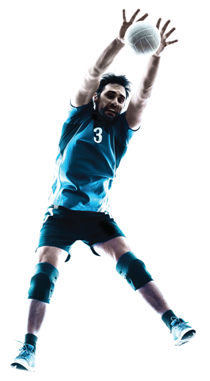Set, Bump, Spike, and Remember to Keep Shoulders Free of Injury During Volleyball
- < Back to Articles
- September 22, 2015

Volleyball involves repetitive and strenuous use of the upper extremities, and the shoulder joint is at risk for both acute and overuse injuries. The overhead motions such as serving, spiking, and blocking can place sudden and heavy strain on a number of structures around the shoulder joint. The most common shoulder injuries in volleyball players include internal impingement and labrum tears.
Shoulder Internal Impingement
Internal impingement of the shoulder may result from improper techniques when serving or spiking the ball, or from extensive overuse of the arm, even with a proper technique. Overhead athletes, including volleyball players, repetitively place the arm into extreme positions. This motion may, over time, lead to excessive stretching in the front part of the shoulder, resulting in partial tears of the rotator cuff and tears of the labrum (ring of cartilage that surrounds the shoulder socket).
Athletes with shoulder internal impingement typically complain of pain with overhead activities, especially during the wind-up part of the serve or spike. The condition is usually diagnosed by a careful physical examination; special imaging tests such as an MRI or an ultrasound. The typical initial treatment for internal impingement is non-surgical, unless the tears are significant. Stretching of the shoulder to properly balance the shoulder joint is very important, and is also combined with exercises to strengthen the rotator cuff and normalize motion of the shoulder blade. The more severe cases may require surgical intervention to repair the rotator cuff tear and/or the labrum, and possibly to tighten the front part of the shoulder.
SLAP Tears
The other injury seen relatively commonly in volleyball players, as well as in other overhead athletes, is a tear of the superior labrum, called the SLAP tear. The labrum—the ring of cartilage attached to the rim of shoulder socket—functions primarily to increase stability of the shoulder, and serves as an attachment for the shoulder ligaments and the biceps tendon. These tears typically occur from repetitive motions where the biceps pulls back on the arm as it is brought into rotation—a movement typical in overhead sports.
A SLAP tear may cause deep-seated shoulder pain, weakness of the arm, including an occasional “dead arm” sensation, as well as clicking and catching sensation in the joint. Sometimes these tears allow joint fluid to leak out and form a cyst, which may compress the nerves that supply muscles of the rotator cuff. In such a case the athlete may present with no pain but complaining of weakness with overhead motion, for example a weak serve. Physical examination may reveal weakness of some of the rotator cuff muscles even without any tears of the rotator cuff. In these cases, surgical treatment to repair the SLAP tear and remove the cyst is warranted. The repair is typically done arthroscopically, and requires about six months of recovery and rehabilitation prior to return to overhead sport, such as volleyball.
Prevention
While the shoulder of a volleyball player is subject to high forces and potential for injury, significant problems can be avoided with a proper training program and adequate time for rest and recovery. Volleyball players may be particularly predisposed to overuse shoulder injury if they have inadequate core strength, as well as abnormal position/motion of the shoulder blade. In order to prevent injuries and overuse conditions of the shoulder, a volleyball player should participate in a regular training program, which includes stretching and strengthening exercises. Specific attention must be paid to core strengthening. Timely evaluation by a sports medicine physician should be performed for all volleyball players who sustain an injury, or have symptoms that are persistent or recurrent..



